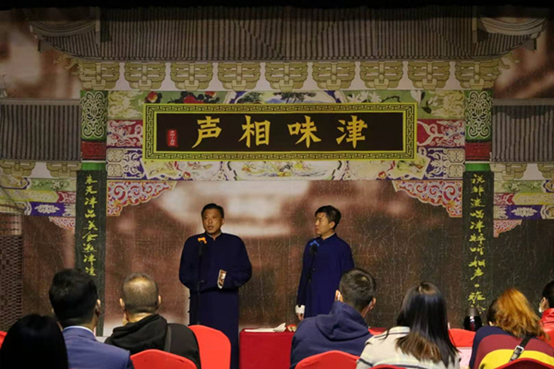Xiangsheng: the Laughter and Wisdom of Tianjiners

In the early years of Guangxu Emperor's reign (AD1871-1908), a Manchu named Yu Erfu (裕二福) arrived in Tianjin and began performing crosstalk at the Beikai Market. This marked the earliest introduction of crosstalk to the city. The term "huaguo" (画锅), which literally means "drawing a pot" in the sand on the ground, referred to the way crosstalk performers made a living, highlighting their reliance on this art for their livelihood.
By 1900, as more performers arrived, notable figures, such as Li Dexi (李德锡, whose stage name is Wanrenmi), Jiao Dehai(焦德海), Ma Delu(马德禄), Zhang Dequan (张德泉, the stage name of whom is Zhang Mazi) and Guo Ruilin (郭瑞林), began to perform at Mingdi in Xicheng. Some of these performers traveled regularly between Beijing and Tianjin, while others settled in Tianjin, taking apprentices and contributing to the development of crosstalk in the city.
Manchu crosstalk performers, known as Qingmen(清门), were akin to amateur enthusiasts today and did not rely solely on their art for income, which set them apart from the Hunmen folk performers(浑门). Many of these Qingmen were banner descendants who faced significant challenges in seeking to survive through public performances. During this time, Tianjin's Sanbu Guan area (it refers to areas where governmental authority or control is absent) became a vital venue for street performers, serving as the birthplace of crosstalk performances.
From the 1930s onward, many crosstalk artists transitioned to theater-style venues like Xiaoliyuan and Daguan Garden. To perform crosstalk in these spaces, one needed to be quite established. Notable figures in crosstalk that audiences recognize today include Hou Baolin(侯宝林), Zhang Shoucheng(张寿臣) and Ma Sanli (马三立).
New Changes in Tianjin Crosstalk
1. Youth Engagement in Crosstalk
Today, Crosstalk has become a vibrant attraction in teahouses and theaters, drawing tourists to Tianjin. These intimate crosstalk venues are often packed, with a large portion of the audience being young people. Some teahouses even plan special performances for holidays like Christmas and Valentine's Day, underscoring the art form's popularity.
2. The Internet + Crosstalk Model
The rise of mobile internet has introduced the Internet + Crosstalk model, with short videos, social media and entertainment shows becoming key platforms for promoting crosstalk culture. This approach challenges the traditional notion that one must visit a teahouse to enjoy crosstalk, as mobile devices now allow laughter to be shared everywhere. The 2018 Youku series Cross Talk (相声有新人)was a pioneering attempt to bring crosstalk into the realm of variety entertainment, showcasing new talent through performance competitions and presenting crosstalk in a fresh, engaging format. Additionally, the user-centric approach has become an important factor in creating crosstalk content aimed at contemporary youth.
3. Being Appealing to Mass Audience
Creators are now incorporating internet humor and relatable everyday themes into traditional forms of crosstalk, making it more accessible and engaging. This shift fosters greater interaction between performers and audiences. While performers might still wear traditional attire and wield folding fans, they often incorporate comedic songs and sketches, with some even singing popular songs, while fans wave glow sticks in support. Crosstalk culture has become increasingly commercialized in the current market environment, with crosstalk brands emerging nationwide. Listening to crosstalk has become a mainstream form of entertainment, akin to listening to music or watching movies.
Although technological advancements have brought crosstalk closer to the audience, experiencing true traditional art requires visiting a crosstalk teahouse. The immediate interaction in these physical spaces creates a unique atmosphere, filled with the aroma of tea and the spontaneous joy of performance. Even fleeting visitors find companionship in the laughter and entertainment.
As a representative cultural form of Tianjin, the thriving development of crosstalk is a source of pride for its people. The crosstalk industry still has a long way to go, necessitating the adoption of successful practices from similar industries in other provinces. There is a need to enhance talent development, nurturing excellent crosstalk performers, creators and managers, while also considering audience consumption patterns to build a dedicated audience base. This will help Tianjin's traditional art enter the new era and reach beyond the city and even China.
Related articles
-
 Tianjin's Canal Culture: A Vital Hub of the Grand Canal System
Tianjin's Canal Culture: A Vital Hub of the Grand Canal SystemMore
-
 Clay Sculpture Legacy: the Century-old Tradition
Clay Sculpture Legacy: the Century-old TraditionMore
-
 Shidiao: the Opera that Brings Reputation to Tianjin as “City of Folk Arts”
Shidiao: the Opera that Brings Reputation to Tianjin as “City of Folk Arts”More
-
 Echoes of Concession: The Cultural Legacy of Tianjin's Foreign Enclaves
Echoes of Concession: The Cultural Legacy of Tianjin's Foreign EnclavesMore
-
 Tianjin Pingshu:One of the Funniest Folk Art Forms in China
Tianjin Pingshu:One of the Funniest Folk Art Forms in ChinaMore
